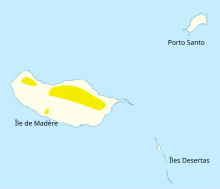Silver neck dove
| Silver neck dove | ||||||||||
|---|---|---|---|---|---|---|---|---|---|---|

Silver- necked pigeon ( Columba trocaz ) |
||||||||||
| Systematics | ||||||||||
|
||||||||||
| Scientific name | ||||||||||
| Columba trocaz | ||||||||||
| Heineken , 1829 |
The trocaz pigeon ( Columba trocaz ), sometimes Madeira pigeon called, is one of Madeira endemic pigeon . It is similar to the laurel pigeon and Bolles laurel pigeon , which are endemic to the laurel forests of the Canary Islands. The population is about 7,000 animals, whereby the protection of the laurel forests on Madeira was very beneficial. The rats, which are common across Madeira, are among the species’s greatest threats.
The silver neck pigeon is listed by the EU in Appendix I of the protected bird species.
External features
The silver neck dove is up to 42 centimeters long. The males weigh around 500 grams, while the females weigh only 400 grams. The silver-necked pigeon is thus somewhat larger and clumsier than a wood pigeon .
The silver-necked pigeon is predominantly dark in color, but overall very similar to the wood pigeon. However, it lacks the white on the wings. The chest has a purple tinge. It has silvery spots on its neck and a light-colored transverse band stretches across its tail. The beak is orange-red in the adult bird, brown-red in young birds, the iris of the eye is light yellow, and the legs are crimson.
Habitat and behavior
The silver-necked dove lives in the laurel forests in the mountains of northern Madeira. However, it also occurs in the growing areas on Madeira and can cause some damage there. The brood is not tied to a season. However, most clutches can be found between March and May. There can be up to four broods per year. However, the clutch only ever comprises one egg. The nest can be found in trees, bushes, but also on rocky outcrops.
The silver-necked pigeon feeds on fruits, especially those of the Azores laurel . It also eats seeds, grass and insects.
Keeping in human care
The Berlin Zoo kept silver neck pigeons from 1914 and was able to successfully breed with these birds from 1915. Breeding was not stopped until 1945. Otherwise, breeding of the silver-necked pigeon is very rare - before the long-term success of the Berlin zoo, breeding was only successful once in 1908.
supporting documents
Individual evidence
literature
- Gerhard Rösler: The wild pigeons of the earth - free life, keeping and breeding , Verlag M. & H. Schaper, Alfeld-Hannover 1996, ISBN 3-7944-0184-0 .
- Martin, A. et al. JA Lorenzo [2001]: Aves del Archipielago Canario. Francisco Lemus Verlag, La Laguna - Tenerife, 787 pp.
Web links
- Columba trocaz in the Red List of Threatened Species of the IUCN 2008. Posted by: BirdLife International, 2008. Accessed January 31 of 2009.

